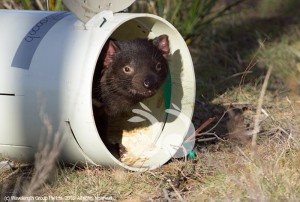Bree’s Babies Bring Hope
BREE a Tasmanian devil who was born in the Barrington and released in Tasmania has become a mum.
It is still early days, so a head count is not possible, but it has been confirmed she has joeys in the pouch.
Devils are pregnant for 21 days and when the joeys crawl into the pouch they are the size of a grain of rice, when they are 30 days old they are approximately the size of a jelly bean.
Bree’s joeys are probably two months old and are expected to emerge from their burrow between September and November.
Tim Faulkner, general manager of the Australian Reptile Park said they were excited that Bree had joeys it was no silver bullet for the plight of the devils, in fact Bree and her joeys are still susceptible to the cancer killing the species.
“This is a milestone but one piece of a big puzzle, it’s nice that it works, but we are talking about a species that in 1996 there were 200,000, now they are in the low 10s of thousands, 90 percent are gone,” said Mr Faulkner.
“At this point in time there is no cure, no vaccine, they can’t stop the disease,” he said.
“Bree has gone back to the Forestier and Tasman Peninsula it’s a large area, but it has a bottle neck because there is a landbridge that is only about 500 metres wide that has been fenced so that the disease can’t get there because it is separated from the mainland of Tasmania.
“Extinction in the wild is likely, but Devil Ark’s role is an insurance for the worst case scenario, if the disease burns itself out we can still have a healthy population,” Tim Faulkner said.
The Devil Ark is viewed as a great conservation model which Tim hopes could be used by other species, but he would also like to see a trial on the mainland to release the devils and help other threatened species.
“If we bred a million bilbies and put them out, you’re just going to feed the fox population,” Mr Faulkner said.
“The academic consensus across Australia is that we should trail releasing same sex devils into the wild, we don’t have a good history of introducing species in this country, dog, cat, goat, foxes, cane toad, but this is not introduction, it’s reintroduction because it was here 2,000 years ago and in evolution that is the blink of any eye,” he said.
“Case studies show it can work, wolves were reintroduced back into Yellow Stone national park as an apex predator and they’ve restored the ecosystem there, everything has changed, everything is alive again and it is hailed as one of the world’s greatest successes.
“The unfortunate thing here is the Tasmanian government owns the devils and they can say no even if the mainland wants it to happen, so it’s just going to take time.
“The issue is very dear to me for a number of reasons with species on the mainland like the brushtail bettong the eastern quoll, thee eastern barred bandicoot all of these species have become extinct on the mainland because of the fox and cat but in Tasmania they are still common so they have a top end predator maintaining balance,” he said.
We’ve got community up there that has overwhelmed us with their welcome for the Tasmanian devil and they get that it’s not a stock predator because it is a scavenger, they get it and that’s really encouraging, we’ve just got to get over the Tasmanian hurdle and the Barrington as one of a few suggested areas could be a good place to start,” Tim Faulkner said.
 scone.com.au
scone.com.au